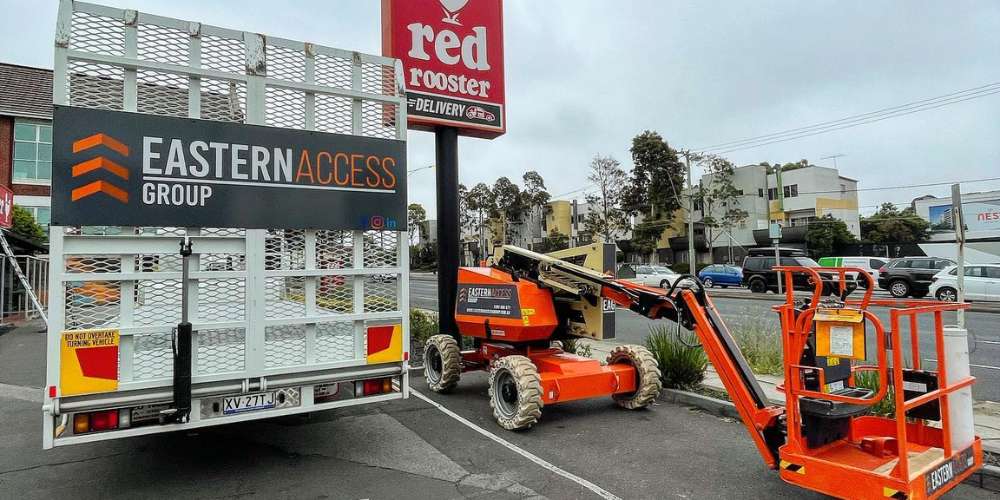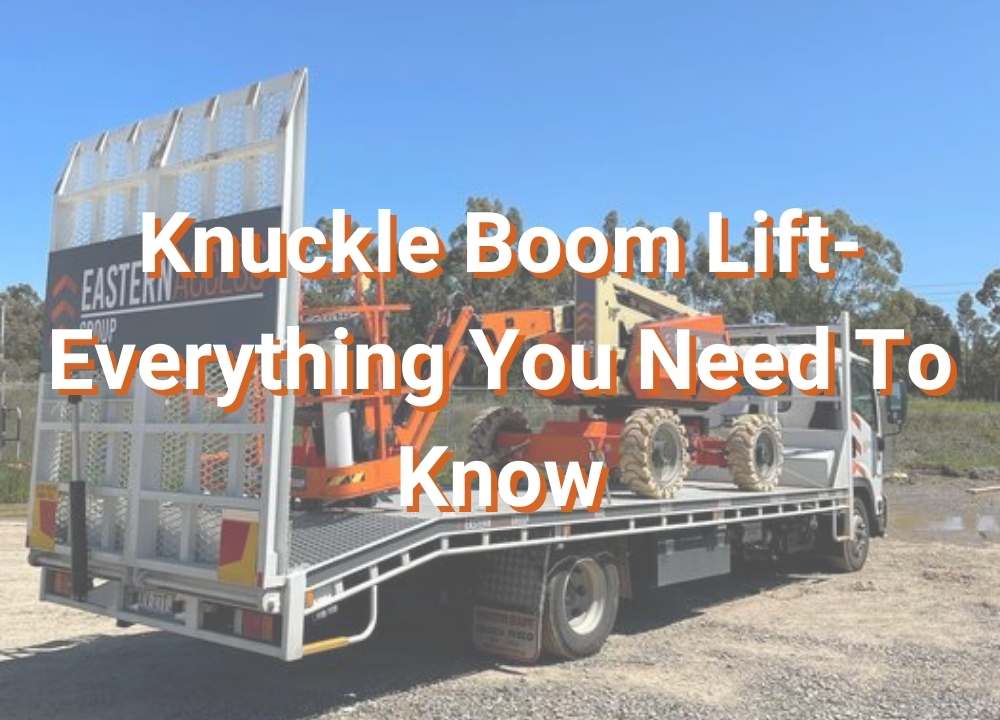Knuckle Boom Lifts-Everything You Need To Know
Aerial work platforms (AWPs) and mobile elevating work platforms (MEWPs) come in five different varieties, each with pros and cons. One of the most common AWPs is the knuckle boom lift, commonly referred to as the articulating man lift. It gives a great deal of flexibility and mobility.
Join us while we discuss the knuckle boom and its different uses in aerial work industries.
Table of Contents
Knuckle Boom vs Straight Boom Lift – How Do they Differ?
The knuckle boom and straight boom lift are both lifting apparatuses used in the construction industry. Both of which are types of boom lifts. Knuckle boom lifts are also known as articulating boom lifts while straight boom lifts are known as telescopic boom lifts.
- The main difference between a knuckle boom and a straight boom lift is that a knuckle boom has an extended arm attached to the end of each leg. In contrast, the boom lift does not have an extended arm. Instead, the boom lift extends from a single point on its base.
- The knuckle boom lift is the best option if you require a boom lift that can manoeuvre in small places and can go over obstacles. Depending on the desired height, this machine may be positioned and then adjusted. The articulated boom lift’s components may each be independently changed to accommodate different work sites. When compared to the telescopic boom lift, the articulated boom lift is often more versatile.
- While articulating versions are more suited for manoeuvring people and things around barriers and into various positions with agility, telescopic types are better for positioning people and stuff and keeping them there.

Uses of Knuckle Boom
Using a knuckle boom lift, you can pick up and move anything from a refrigerator to an entire apartment. The main advantage of using this equipment is that it can be used in almost any situation, including those that would require lifting heavy objects without the use of a crane.
The knuckle boom lift has many uses:
1. It can lift and move things like refrigerators, televisions, and other large appliances.
2. You can also use it to move furniture or large pieces of lumber.
3. It is also possible to use a knuckle boom lift to lift people over short distances, allowing you to reach places where you otherwise couldn’t have gotten them.
4. This machine can also be used for rescue operations when people are trapped in buildings after natural disasters such as earthquakes or hurricanes.
5.The knuckle boom lift can be used for both indoor and outdoor purposes. It can be used in construction sites where specific areas are required to be lifted out of the ground or into a building site where an area needs to be cleared away.
6. Knuckle boom lifts can be used to move large pieces of machinery from one place to another or from a manufacturing facility to an outbuilding that needs repair or maintenance.
7.The knuckle boom lift is an excellent option for warehouses as it allows you to move large quantities of goods without worrying about the strain on your back or other body parts. The knuckle boom also offers an easy way to carry multiple items without straining yourself.
How Does a Knuckle Boom Lift Works?
A knuckle boom is a type of crane used to lift heavy objects. The main components of a knuckle boom are the hub, the arm and the pintle.
The hub is the centre point of rotation for the knuckle boom. It attaches to the support structure of the building where it will be lifted. This support structure can be in the form of existing structures such as walls or floors, or it can be made from scratch if needed.
The arm is what lifts the load into position. It has three points called pintles that connect directly to points on either side of a supporting beam or column. These pintles allow for great flexibility when lifting different objects and help prevent damage to anything being lifted because they provide stability during operation.
You must register for a safety training course to use a knuckle boom lift. This enables you to learn about a knuckle lift’s controls and how to operate it on various terrains. It also helps you learn more about the risks associated with knuckle lift operations and how to prevent mishaps and injuries.
To maintain your equipment functioning to its best capacity, the battery wiring should be checked each month. Ensure there are no wire insulation breaks that can result in a potential short while inspecting the wiring and wire connections. You should also ensure the terminals are tight and corrosion-free for a clean and tight connection.
Benefits of Using a Knuckle Boom
Using a knuckle boom is a safer way to lift heavy objects than any other aerial lifts. The knuckles are less likely to bend and be damaged, which makes it easier for you to use the device in your work environment. It also has greater strength than most other lifting devices because it uses the entire body’s weight instead of just one arm or leg at once.
1. It is easier to use than a typical boom because it has a handle you can hold on to.
2. The knuckle boom has a padded grip that makes it comfortable to hold, even if you are wearing gloves and holding them for long periods.
3. The knuckle boom offers more flexibility and mobility than other booms, which makes it ideal for working in tight spaces or around obstacles like furniture and objects that get in the way of your work area.
4. The knuckle boom’s design allows you to adjust the boom’s length, height and angle, allowing you to achieve the perfect position while working with it on any surface or material type (wooden flooring, carpeting, tile floors etc.)
Frequently Asked Questions
Although compact and simpler to operate in remote locations, they are nonetheless quite effective since they can lift loads weighing up to and over 60 tonnes. A winch may be added to the knuckle boom for other lifting choices.
Multiple boom sections on aerial work platforms, known as “articulating booms”, allow the operator to pass over obstacles and impediments to reach work areas.
All aerial lifts require some basic training and certification for safe handling. Each operator has to get training on how to use the lift’s capabilities, check the machinery before each shift, and spot and stay clear of dangers. Therefore, training is provided, and recommendations are made to be followed before someone may operate an excavator on the job to guarantee work sites are secure and equipment is operated appropriately.
A knuckle-boom lift is designed to be a material handling crane, able to pick and position objects as well as load and unload cargo. A winch is especially included in a stick-boom crane, which is designed to serve as a lifting tool and enables more accurate lifting and holding of components while maintaining equipment.
Key Takeaways
There are undoubtedly different types of boom lifts. However, it’s important to note that there is no universally-accepted definition of the term. Typically, these lifts will have a drum with a hook at the end, without a hoist mechanism. The hook is intended to engage with a knuckle boom and lift the load. Still, the selection of hook design will depend on whether you intend to use a counterbalance system at the outset or change this in later stages of hoisting operations.
There is more to the knuckle boom lift than meets the eye. This special industrial equipment is used in factories and warehouse facilities to move materials. The mechanism attached to the boom allows for much movement and shifting within its vicinity. The knuckle boom lift is mainly used for lifting heavy materials such as shipping containers, trailers, drums, etc.

